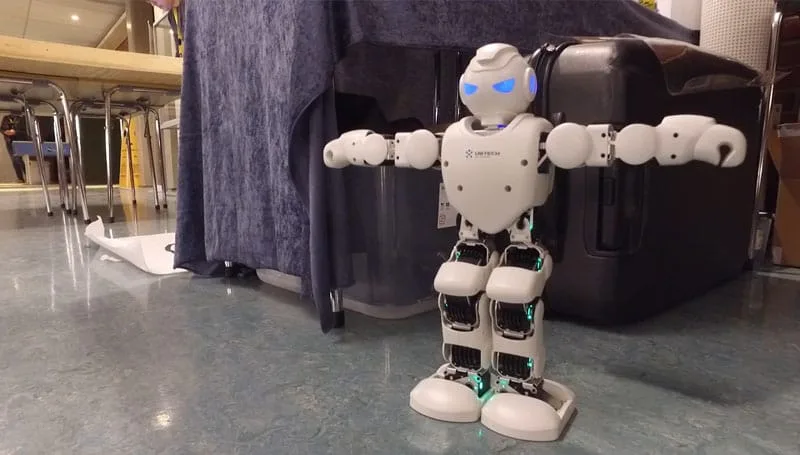Humanoid Robots: Your Next Coworker Might Be Made of Metal

We’re standing at the precipice of a new era of job automation. Recent advances in AI are already reshaping the job market, and advanced robotics are catching up.
Several companies are designing humanoid robots. Unlike stationary machines that are made for a specific purpose, these are developed for versatility, dexterity, and AI-powered cognitive processing. This enables them to operate alongside humans.
Humanoid robots and androids with AI capabilities may just be the future of work. This has the potential to improve efficiency and productivity, but it also comes with ethical implications regarding the job market itself.
The Evolution of Humanoid Robotics: More Than Just Machines
The past decade or so has witnessed many advancements in robotics hardware and software.
Dexterity and Mobility
Modern artificial muscles, typically made from polymers of pneumatic systems, allow for more naturalistic movements and better dexterity. Advanced sensors also provide androids with improved perception of their surroundings. This is important for navigating a human environment and interacting with people or objects.
Companies like Boston Dynamics are working on advanced systems that show remarkable balance and agility, while Tesla’s Optimus and Apptronik’s Apollo are engineered for practical human-scale uses.
AI Integration
Recent advances in commercially-available and functional AI have basically given the androids a new “brain”. Machine learning algorithms allow humanoid robots to make decisions in real time, as well as to “understand” and respond to commands and complex instructions. It can also learn from experiences and adapt to new situations.
Developments in emotional AI (such as robots like Ameca and Sophia) help create a more natural human-robot interaction.

Case Studies of Early Adoption
Widespread adoption is still unlikely, but there are many early case studies for the potential uses of humanoid robots and AI in the workplace:
- Manufacturing: they could help with repetitive, physically demanding tasks and address labor shortages. Especially for dexterous tasks that fixed robots struggle with and that traditionally required a human to do them.
- Healthcare: AI is already being used to diagnose patients, and advanced robotics have a history of being used in surgery. In the future, AI-powered humanoid robots can assist with patient communication, taking vital signs, and doing simple checkups. They can also provide comprehensive elder care.
- Hospitality: robots like Kime are being tested for concierge services and for serving food and beverages
- Education: robots like NAO and Pepper are being tested as interactive teaching tools, especially to teach programming and STEM concepts.
- Logistics: humanoid robots can be used in warehousing and logistics to optimize and automate supply chains.
AI in the Workplace: Paving the Way for Android Coworkers
The integration of AI into the workplace is already well underway, even if humanoid robots are not quite there yet. AI is used in a range of repetitive, mundane, and data intensive tasks. For example, CV filtering, data entry, customer service chatbots and other virtual assistants, personalized marketing emails, big data analytics, etc…
Ideally, this should free up human employees for more higher value activities that require creative input, strategic thinking, or complex problem-solving.
The Economic and Social Implications of Job Automation
Job loss is the most significant concern with humanoid robots and AI in the workplace. It is believed that it will affect routine and low-skilled tasks the most.
Luckily, there’s a historical pattern here. Whenever a new technology causes widespread job displacement, there’s always new industries and positions that open up in their place.
The rise of humanoid robots will fuel the need for robotics engineers, data scientists, AI specialists, and robot maintenance technicians.
The Future of Work: A Hybrid Workforce
The economic growth and efficiency from automation can also lead to the creation of new unforeseen opportunities.
The Widening Skills Gap and the Need for Reskilling
A more automated workforce means there will be a skill gap. Employees replaced by robots should get the opportunity for reskilling and upskilling in other roles. This requires concerted efforts from governments, businesses, and educational enterprises.
Lifelong learning will be the norm. The employee of the future will be the one that is most adaptable, creative, emotionally intelligent critical thinkers. These skills are harder for robots to replicate.
Social and Ethical Considerations
Besides the potential disruption to the current job market, introducing robots with AI in the workplace raises other ethical and social considerations:
- Surveillance: when robots are introduced into the workplace with advanced sensors and AI, they pose a significant privacy risk. It will be important in the future to ensure data security and prevent their misuse.
- Bias and discrimination: AI learns from training data that may show biases towards certain groups. This can lead to discrimination when these robots are deployed in the workplace and have to interact with the public.
- Accountability: who is responsible when a robot makes a critical mistake? Legal and ethical frameworks need to establish this clearly.
- Psychological impact: having human-like robots at work, in businesses, and in public places can have a significant psychological impact on humans. For example it can exacerbate loneliness.
Navigating the Human-Robot Frontier
It’s difficult to predict when humanoid robots will join the workforce, but experts estimate that it could become possible by the late 2030s or 2040s.
Several factors will influence this timeline, including technological advances in battery life, processing power, AI capabilities, and mass scale production and pricing of robots.
Aside from technology, it will also depend on whether there are legal frameworks in place, and the level of societal acceptance towards the idea.
To prepare for the future, workers will have to embrace continuous learning and acquire more uniquely human skills that are less likely to be automated. Businesses and governments will also need to invest in reskilling and upskilling their workforce.
The workplace of the future will have humanoid robots working alongside humans. The robots will likely do repetitive and menial tasks, physically-demanding tasks, or heavy data processing. The human workers will either maintain the robots, or will focus on tasks requiring creativity, empathy, critical thinking, and complex problem-solving.




